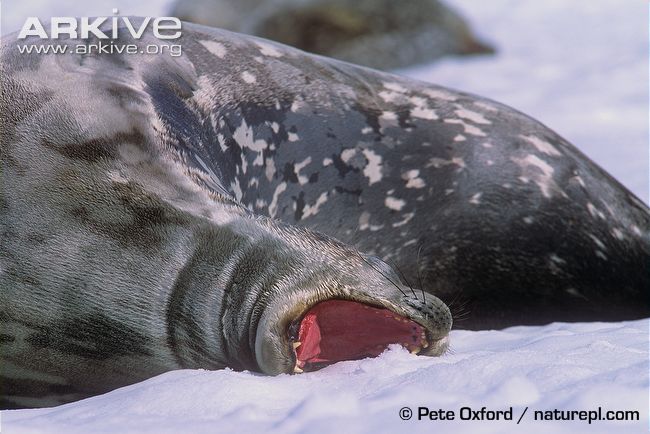Adaptation
The Weddell seal lives in polar regions of the world, specifically in Antarctica, which means it must be able to survive in an extremely cold environment. The Weddell seal is a skilled diver and can dive up to depths of 600 meters as well as stay underwater for up to an hour (Sterling, I. 1971). They spend most of their time in the water and swim around using their fore flippers and hind flippers, which they use to propel themselves through the water.
When on land, however, they move in a slow, inching motion making them vulnerable to predators such as other seals that are able move faster on the ice. The Weddell seal contains a large amount of myoglobin in their muscles along with red blood cells. Their oxygen carrying capacity is thus greater than in other seals and allows the Weddell seal to remain underwater for long periods of time (Red Orbit 2014).
 Furthermore, after
long dives, the seal must come up to the surface and
breathe through various cracks or holes found in the
ice. When these surface openings are not available, the
seal will use its canine and incisor teeth to bite
through the ice to create new holes to breathe. However, this breaks down the
seal’s teeth much faster resulting in a shorter lifespan of
about 20 years (Australian Antarctic Division 2010). In
addition, the seal has whiskers on its face which detect
stimuli such as a sudden movement of a nearby fish while
underwater (Red Orbit 2014).
Furthermore, after
long dives, the seal must come up to the surface and
breathe through various cracks or holes found in the
ice. When these surface openings are not available, the
seal will use its canine and incisor teeth to bite
through the ice to create new holes to breathe. However, this breaks down the
seal’s teeth much faster resulting in a shorter lifespan of
about 20 years (Australian Antarctic Division 2010). In
addition, the seal has whiskers on its face which detect
stimuli such as a sudden movement of a nearby fish while
underwater (Red Orbit 2014).
List of references used in this section:
Stirling, I. 1971. Leptonychotes weddelli. Mammalian Species. No. 6. The American Society of Mammalogists.
Red Orbit 2014. <URL: http://www.redorbit.com/education/reference_library/animal_kingdom/mammalia/1112647140/weddell-seal-leptonychotes-weddellii/> Accessed 21 April 2014.
Choose your adventure:
To learn about what Weddell seals eat, click here.
OR
To return back to the home page, click here.